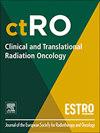定义局部晚期咽喉癌放疗后的失败模式和动力学:现代现实世界的见解!
IF 2.7
3区 医学
Q3 ONCOLOGY
引用次数: 0
摘要
我们的目的是评估口咽、下咽和喉部局部晚期鳞状细胞癌患者在接受调强或调容弧线治疗(RT)加或不加全身治疗的情况下,局部复发(LRR)的患病率和模式、结局和预后因素。方法213例2016 - 2023年收治的患者中,177例符合纳入标准。LRR定义为原发肿瘤区域或区域淋巴结的复发。失效模式根据复发模型进行分类,包括中心高剂量(a)、外周高剂量(B)、中心选择性(C)、外周选择性(D)和场外复发(E)。结果50/177例(28.2%)患者有slrr,复发病变81例。大多数复发发生在放疗后的第一年内(39/177,22.0%),主要发生在hpv阴性患者中。大多数失败发生在高剂量靶体积内(65%为A型,14%为C型),22%的病例出现边缘性复发(B型和D型),5%的患者出现E型。hpv阳性患者的LRR较低(16.0% vs. hpv阴性患者的34.4%)。多变量分析发现HPV状态是OS、PFS和LRR的重要预后因素。远处转移的发生对OS、PFS和LRR均有负面影响。LRR有加重OS的趋势(p = 0.072)。化疗对PFS和LRR有显著影响。结论lrr仍然是一个挑战,特别是在hpv阴性患者中。大多数失败发生在中心,但边缘和场外复发强调需要改进目标描绘和自适应RT策略。需要进一步的研究来优化高危患者的治疗。本文章由计算机程序翻译,如有差异,请以英文原文为准。
Defining failure patterns and dynamics in locally advanced pharyngeal and laryngeal SCC following radiotherapy: Real-World Insights in the modern Era!
Introduction
We aimed to evaluate the prevalence and patterns of locoregional recurrence (LRR), outcome and prognostic factors in patients with locally advanced squamous cell carcinoma of the oropharynx, hypopharynx, and larynx treated with intensity-modulated or volume-modulated arc therapy definitive radiotherapy (RT) with or without systemic therapy.
Methods
Of the 213 reviewed patients treated between 2016 and 2023, 177 met the inclusion criteria. LRR was defined as recurrence in the primary tumor region or regional nodes. Failure patterns were classified based on a recurrence model, including central high-dose (A), peripheral high-dose (B), central elective(C), peripheral elective (D), and out-of-field recurrence (E).
Results
LRR was observed in 50/177 (28.2%) patients and 81 recurrent lesions. Most recurrences occurred within the first year after RT (39/177, 22.0%), predominantly in HPV-negative patients. The majority of failures were within the high-dose target volume (65% type A, 14% type C), with marginal recurrences (types B and D) occurring in 22% of cases and type E in 5% of patients. HPV-positive patients had fewer LRR (16.0% vs. 34.4% in HPV-negative patients).
Multivariate analysis identified HPV status as a significant prognostic factor for OS, PFS and LRR. The occurrence of distant metastases showed a negative impact on OS, PFS and LRR. LRR showed a trend toward worse OS (p = 0.072). Chemotherapy had a significant effect on PFS and LRR.
Conclusion
LRR remains a challenge, especially in HPV-negative patients. Most failures occurred centrally, but marginal and extra-field recurrences highlight the need for improved target delineation and adaptive RT strategies. Further research is needed to optimize treatment in high-risk patients.
求助全文
通过发布文献求助,成功后即可免费获取论文全文。
去求助
来源期刊

Clinical and Translational Radiation Oncology
Medicine-Radiology, Nuclear Medicine and Imaging
CiteScore
5.30
自引率
3.20%
发文量
114
审稿时长
40 days
 求助内容:
求助内容: 应助结果提醒方式:
应助结果提醒方式:


